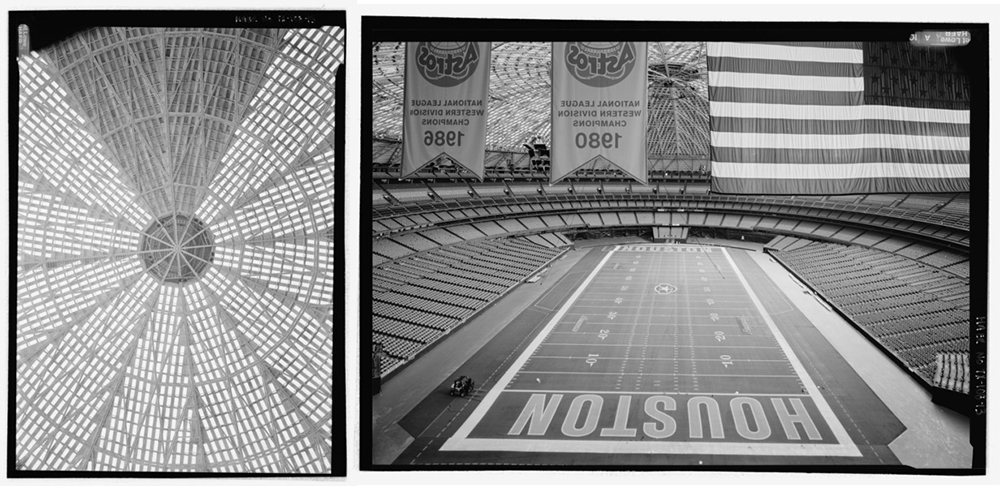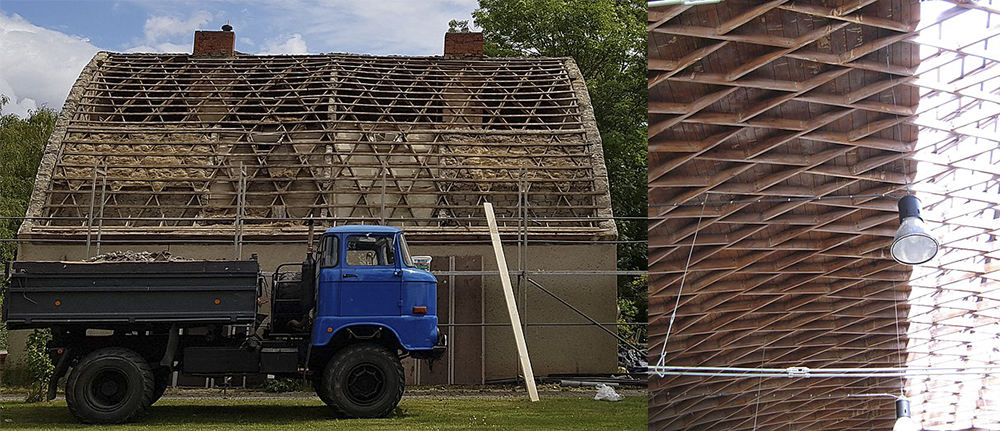Lamella structure
Contents |
[edit] Introduction
A lamella or lamellar structure is normally made up of a series of smaller component parts, often of the same material and one that could potentially be a lamella board but also timber or steel. A lamella structure may also be referred to as a reciprocal grid because the individual members reciprocate support to neighbouring members in a grid form, thus acting as a whole in unison, they are similar to and may be referred to as gridshells, geodesic domes or reciprocal roofs and reciprocal grids as well as Zollinger roofs. See also Lamella Board.
[edit] Components
In most cases reciprocal lamella structures will be made up of elements which are twice the length of each grid unit, so that the next member is supported at the midpoint of the previous. This type of structure allows each member to be made up of relatively thin two dimensional linear beams or plates, in more complex structures these might be cut into certain shapes that interlink or slot together creating three dimensional structures or gridshells. A technique that expanded in popularity with the availability of CNC cutters or 2D routing in the 1970's and 80's.
[edit] Examples
There are many different examples of what might be referred to a lamella structures globally, one of the largest is perhaps the Houston Astrodome, which was the world's first multi-purpose, domed sports stadium, located in Houston, Texas, US, Although now closed it had a record attendance of 67,925 set by the World Wrestling Federation in 2001. The structure is often referred to as being a lamella dome, because it has a diamond shaped pattern on the underside of the spherical surface. It is a domed circular concrete and steel framed building, constructed of steel pieces joined and welded together form a complex domed grid in tension. The dome structure is 220m in diameter, with a ceiling 63 m above the playing surface stands and covering 9.5 acres or 3.8 hectares.
An earlier and well known example of a timber lamella roofing system is called the Zollinger roof, after the German architect, city planner and municipal construction official, Friedrich Zollinger who developed the system. Although relatively labour intensive to construct by skilled workers, the design had a number of advantages including the absence of long tie beams or supporting posts, significantly less material required than traditional roofs, it could adapt to openings and could be made entirely of short pieces of timber which could be prefabricated and installed without large machinery. s such the roofing systems was adopted at times when materials and costs were prohibitive, such as between the World Wars. Historical examples of Zollinger roofs can be found in a house in Schweicheln-Bermbeck and Augustinus church in Heilbronn, Germany, whilst modern examples can be found throughout Europe.
[edit] Related articles on Designing Buildings
- Braced frame.
- Bridge construction.
- Balloon framing.
- Concrete frame.
- Domestic roofs.
- Gridshell.
- Gusset.
- Hammerbeam roof.
- Lamella board.
- Long span roof.
- Pitched roof.
- Portal frame.
- Purlins.
- Sheathing.
- Space frame.
- Structural steelwork.
- Skeleton frame.
- Steel frame.
- Strut.
- Ties.
- Timber engineered structural frames.
- Timber gridshell.
- Timber roof.
- Timber framed buildings and fire.
- Timber post and beam construction.
- Timber preservation.
- Types of frame.
- Types of timber.
- Types of roof.
- Types of structural load.
Featured articles and news
Latest Build UK Building Safety Regime explainer published
Key elements in one short, now updated document.
UKGBC launch the UK Climate Resilience Roadmap
First guidance of its kind on direct climate impacts for the built environment and how it can adapt.
CLC Health, Safety and Wellbeing Strategy 2025
Launched by the Minister for Industry to look at fatalities on site, improving mental health and other issues.
One of the most impressive Victorian architects. Book review.
Common Assessment Standard now with building safety
New CAS update now includes mandatory building safety questions.
RTPI leader to become new CIOB Chief Executive Officer
Dr Victoria Hills MRTPI, FICE to take over after Caroline Gumble’s departure.
Social and affordable housing, a long term plan for delivery
The “Delivering a Decade of Renewal for Social and Affordable Housing” strategy sets out future path.
A change to adoptive architecture
Effects of global weather warming on architectural detailing, material choice and human interaction.
The proposed publicly owned and backed subsidiary of Homes England, to facilitate new homes.
How big is the problem and what can we do to mitigate the effects?
Overheating guidance and tools for building designers
A number of cool guides to help with the heat.
The UK's Modern Industrial Strategy: A 10 year plan
Previous consultation criticism, current key elements and general support with some persisting reservations.
Building Safety Regulator reforms
New roles, new staff and a new fast track service pave the way for a single construction regulator.
Architectural Technologist CPDs and Communications
CIAT CPD… and how you can do it!
Cooling centres and cool spaces
Managing extreme heat in cities by directing the public to places for heat stress relief and water sources.
Winter gardens: A brief history and warm variations
Extending the season with glass in different forms and terms.
Restoring Great Yarmouth's Winter Gardens
Transforming one of the least sustainable constructions imaginable.
























